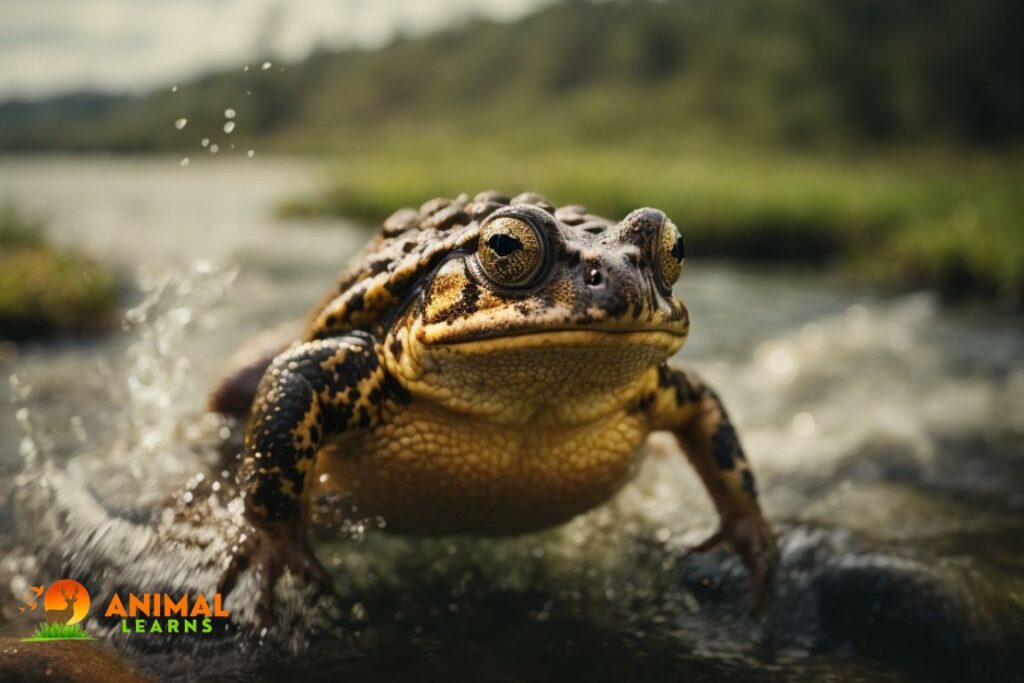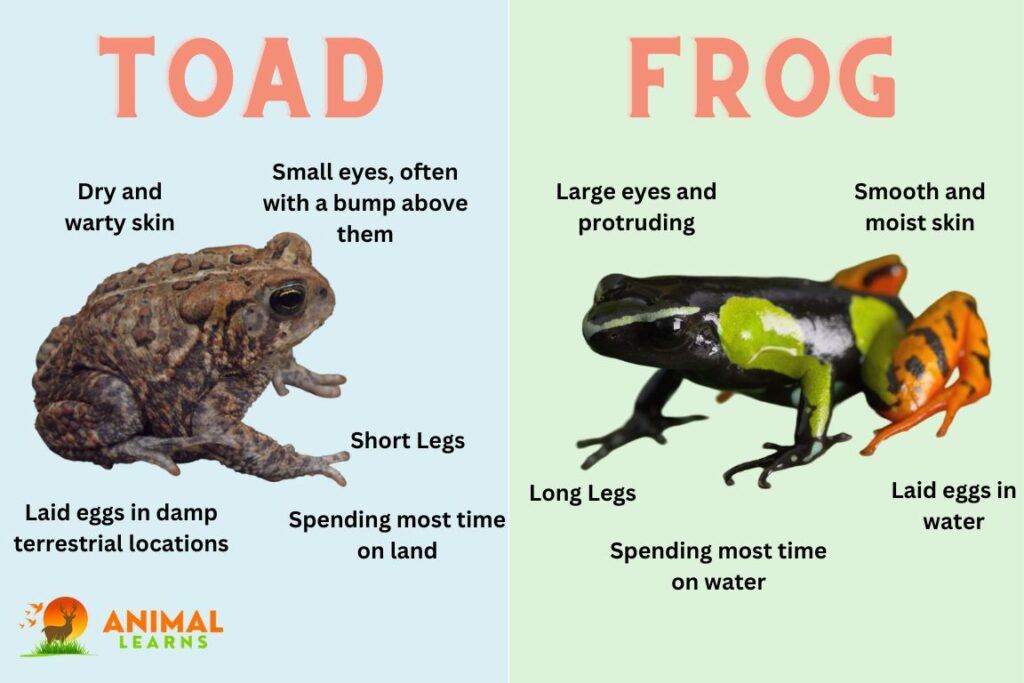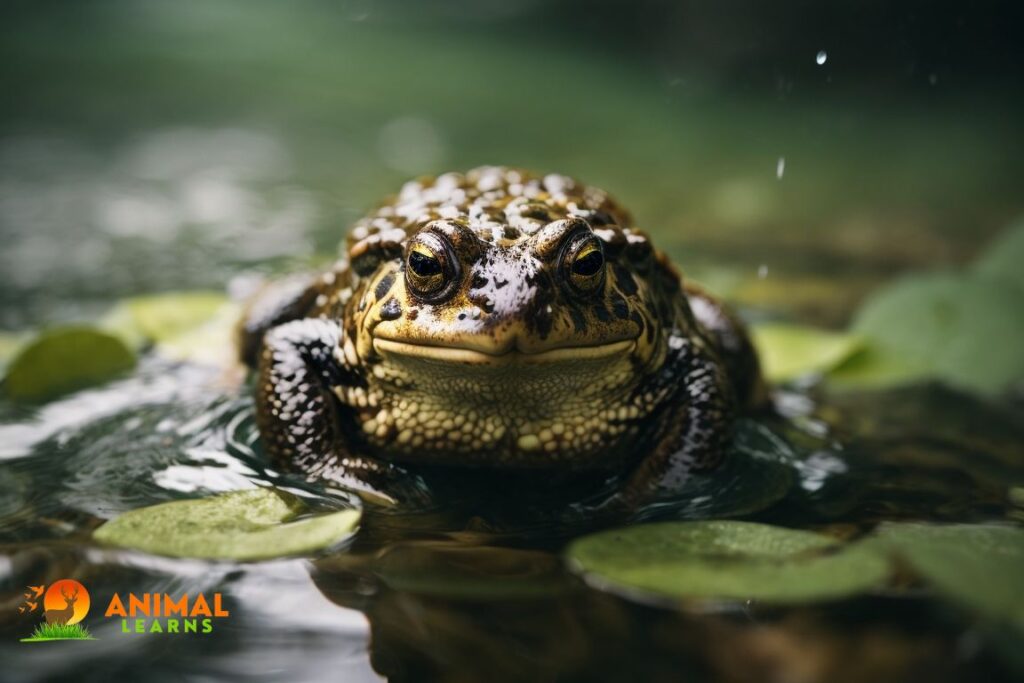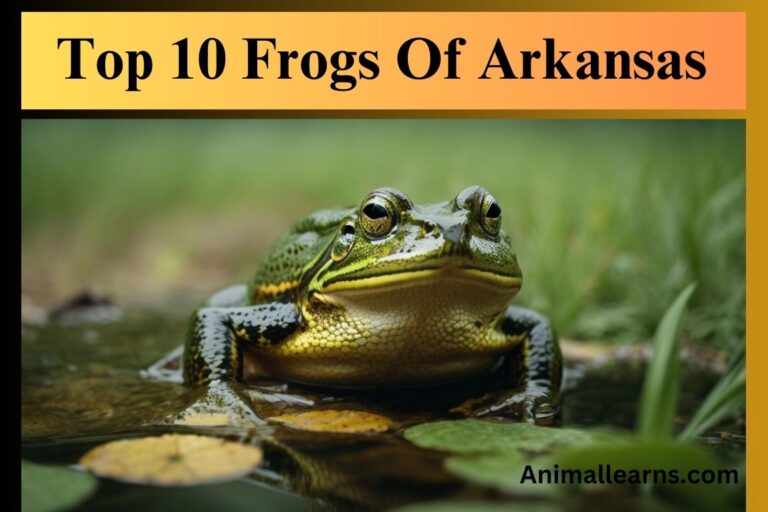Can Toads Swim? Toads and Frogs – Animallearns

“Can toads swim? Toads can swim, although they’re not very adept at it. Toads have sharp fingers to aid in digging. Unlike aquatic frogs, which move through the water on webbed feet. While they spend relatively little time in the water, toads spawn there.
I always thought of toads as terrestrial animals because I used to see them in our garden as a youngster, but then I saw my first water frog. Toads exhibit their adaptability for a terrestrial existence by reproducing in water but spending little time there.
Toads, which are found worldwide with the exception of Antarctica, like wet environments such as fields and meadows. Toads are less skilled swimmers than frogs due to their longer bodies and shorter legs, even though they can swim if needed.
Can toads swim?
Contents
Yes, Toads are capable of swimming! The majority of toad species can swim, albeit not as well as frogs. Similar to a person performing a breaststroke, they move through the water by using their strong rear legs and webbed feet.
When toads need to obtain food, evade predators, or lay eggs, they usually swim. Certain toads, such as the American Toad, have exceptional swimming abilities and may even stay submerged in the water for prolonged periods of time.
It’s crucial to remember that not all toads enjoy swimming. Certain animals, such as the cane toad, would rather stay on land and would only swim when it is absolutely essential.
Are Toads Amphibians?
Yes, Toads are amphibians! As a matter of fact, they are members of the biggest order of amphibians, known as Anura (Greek for “without a tail”). Frogs and a few other less well-known amphibians are also members of this group.
They live half of their life on land and part of them in the sea. Tadpoles are aquatic animals that breathe through their gills. They can survive on land after they reach adulthood and get lungs.
They have moist, permeable skin that helps them to breathe. Unlike reptiles, amphibians lack scales, and in order for their skin to absorb oxygen, it must be wet.
Why Toads Are Not Good Swimmers

Toads use their digits or spaded feet to assist them in crossing land and digging and burrowing underground, in contrast to aquatic frogs that have webbed feet, are proficient swimmers, and spend their whole lives in the water.
Toads breed in water, but they don’t stay in it for very long. Since frogs are amphibians, they live some of their lives both in and out of the water. Although they were born in the water, toads may be found living on land close to woods, marshes, and even cities.
Unlike aquatic or tree frogs, they do not require an aquatic environment to survive. Using their gills for breathing, toads survive and feed in water as tadpoles. Consequently, toads are superb swimmers even as tadpoles. However, they lose their desire to live in water and their tail as they mature into toadlets.
Toads lose a lot of their swimming ability when they are toadlets. For this reason, toads dwell mostly on the ground outside of water during their adult lives.
Can Toads Drown?
It is true that toads may drown. They will eventually suffocate if they are unable to get oxygen since they have lungs. Make sure the enclosure where your pet toad lives has enough water in it—most toads need no more than an inch or two. They might drown if there is too much water in their environment.
Toads vs Frogs: What’s the Difference?

| Feature | Toad | Frog |
| Skin | Dry and warty | Smooth and moist |
| Legs | Short and stocky, better suited for crawling | Long and powerful, ideal for hopping |
| Habitat | Primarily aquatic, spending most time in the water | Primarily aquatic, spending the most time in the water |
| Eyes | Smaller, often with a bump above them | Large and protruding |
| Defense | Produce toxins from parotoid glands behind the eyes | Produce mucus, some have toxic skin |
| Eggs | Laid in damp terrestrial locations | Laid in water |
| Examples | American toad, Fowler’s toad, Surinam toad | Leopard frog, tree frog, bullfrog |
At first appearance, there may not be much difference between these two erratic creatures. A further inspection will, nonetheless, highlight a few notable (and evident) variations.
Frogs and toads are both amphibians, which means that they need a wet environment to live. This also applies to salamanders and axolotls. But unlike toads, frogs are more reliant on moisture, which is why they never go too far from water.
Alternatively, since this is the time of year when they most need access to water, you’re more likely to observe a toad in a dry place, such as a field or meadow, outside of breeding season.
Apart from their inclination for water, frogs appear consistently more glossy and damp in comparison to toads, who usually have a drab and even arid appearance. In addition, toads have rough skin, something frogs do not have.
In general, a toad has a rounder body, shorter legs, and a considerably more squat appearance. Because of their larger legs, frogs can jump farther. A frog’s legs are often longer than its head and body combined.
Do Toads Like Water?
Toads do not require the same level of proximity to water as frogs do. Their bodies are also not made for activities in the water. Taking into account those two things, you might be wondering, “Do toads even like water?”
Indeed, toads are attracted to water. They still require water to thrive, even if they are not as reliant on it as frogs are. Most ecosystems are home to a variety of toad species, all of which depend on water to survive.
The majority of toad species like spending time around shallow, still pools of water. They procreate close to water bodies as well.
Do Toads Lay Eggs in Water?

For the purpose of laying their eggs, all frog species—including toads, tree frogs, and aquatic frogs—need access to fresh water. Since toads only exist as aquatic frogs during their larval stage, adult toads deposit their eggs in water even though they are not as good swimmers as aquatic frogs.
Aquatic frogs are mostly found in water, therefore they have no problem reproducing or mating there. Amplexus is the reproductive method used by frogs, who lay their eggs underwater, near plants, or at the water’s surface.
Though arboreal frogs are not as proficient swimmers as aquatic frogs, most toads and arboreal frogs perform similar functions.
Why Can’t Toads Swim Like Aquatic Frogs?
Because they lack webbed feet to help them move through the water and strong, muscular hind legs to drive them forward, toads cannot swim like aquatic frogs. To help them dig, toads have stubby bodies, short legs, and toes that resemble fingers.
The unique physical characteristics of aquatic frogs include their webbed feet and incredibly long, powerful hind legs, which allow them to swim and jump with ease and sit like springs. Swimming, navigation, and balanced landings all need these limbs.
However, because of their tiny, stubby bodies, toads are unable to jump very far. Although they can hop more swiftly than water frogs, they may also tire out more quickly since hopping requires more energy to avoid predators.
Toads are small, but their powerful hind legs enable them to push dirt out of the way so they may dig burrows. They also have digit-like digits on their feet.
Can toads swim? Toads must be able to swim and float in order to properly lay their eggs since they reproduce in water. After they reproduce, they leave the water, though.
Due to physical restrictions, toads are unable to swim in the same manner as aquatic frogs. Compared to aquatic frogs, they are significantly less nimble and swim more slowly.
How do Toads Stay Hydrated?

Toads are not an exception to the rule that frogs breathe and drink via their skin. However, toads breathe by absorbing the humidity that the surrounding soil emits, in contrast to aquatic frogs that stay hydrated and oxygenated by lying in water.
For aquatic frogs to breathe, drink, and thrive, they need direct access to water. During the day, they spend most of their time in the water, resting, breathing, and drinking water.
They can survive on land for extremely brief periods of time while breathing via their lungs, even though they can leave the water safely.
Toads, on the other hand, are terrestrial, meaning they dig underground to escape predators and live on land. Unlike aquatic frogs, they usually do not swim or sit in water to maintain the moisture content of their skin.
By absorbing the dampness that the earth and surrounding plants generate, they are able to breathe and drink. For the most part, they don’t need direct access to water as much as aquatic frogs.
Myths About Toads

Myth 1: Toads cause warts
This toad myth is arguably the most persistent and widely accepted one. But it’s not grounded in reality. It is viruses, not frogs, that produce warts. Although toads’ rough skin may resemble warts, it is really a normal feature of their anatomy and does not provide a health risk to humans.
Myth 2: Toads Don’t Need Water to Thrive
Untrue. A toad’s ability to live a healthy existence depends on water. They still require water to thrive, even if they are not as reliant on it as frogs are. For breeding purposes, they also require access to sources of water.
Myth 3: Toads pee on you if you touch them
This is just one more false myth. When under stress or in danger, toads may secrete a milky liquid, but this material is not pee. This is a protective secretion that mostly works as a predator deterrent. It won’t injure people or result in any illnesses.
Myth 4: It Is Fine to Take a Wild Toad as a Pet
The third myth is that taking a wild toad as a pet is acceptable. With minimal upkeep, toads make excellent pets, but you should never take a wild toad out of its natural habitat. Toads live their whole lives in one place, only visiting on important occasions and then coming back.
These places provide individuals with a great deal of comfort and turn into their homes. Removing a toad from its habitat will cause significant disruptions to nearby ecosystems. Look through your local pet store if you want a toad as a pet.
Mth 5: Toads are bad for gardens.
This myth is also untrue. Because they consume a lot of insects—many of which are regarded as pests—toads are really good for plants. Toads can enhance crop production and safeguard plants by managing pest populations.
The answer to the question “Can toads swim?” Most toads can swim, but they are not known for their swimming abilities. When one is aware of the unique traits and behaviors of toads, it becomes evident why swimming is not a defining feature of their aquatic existence.”
Conclusion
Whether you watch them in your garden or in a pet cage, toads are amazing and fascinating creatures. It might be challenging to distinguish between toads and frogs, but with practice, you can make the difference. Although toads are aquatic animals and require them for survival, be sure that the container your pet toad is in has enough water in it to prevent drowning.
FAQs
Can all toads swim?
Most toads can swim, but they are not known for their swimming abilities.
Are toads good swimmers?
Generally, toads are not excellent swimmers. They can swim if needed, but it’s not their preferred mode of movement.
Do toads spend a lot of time in the water?
No, toads prefer terrestrial habitats. While they reproduce in water, they spend the majority of their time on land.
How do toads differ from frogs in swimming abilities?
Unlike frogs, toads have shorter legs and larger bodies, making them less efficient swimmers.
Can toads survive in water for an extended period?
Toads are not adapted for prolonged aquatic life; they have specific physical traits that make them better suited for a land-based lifestyle.












